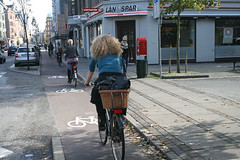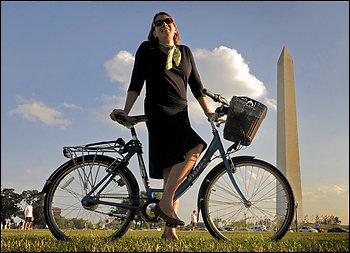Bikes and walking
1. Will calls our attention to this article, "A lane of one's own, an argument for bike lanes," from Momentum Magazine. A data analysis within the article makes the point that bicyclists subsidize drivers quite heavily.
I used to follow the John Forrester line that separated lanes are a bad thing. But I am now convinced otherwise, both by John Pucher and his paper, "Making Cycling Irresistible," see "John Pucher – the Bicycle Scholar" also from Momentum, as well as my pondering more seriously the day to day abuse I experience while riding city streets.
I don't think there is one day that I ride (at least during the work week, Monday through Friday) in the core of the city, when someone doesn't scream at me from their car that I should get off the road or ride on the sidewalk.
Having been a runner in high school, I am used to such abuse. But it's too much to ask of regular people to put up with this--especially women and children.

Separated bicycle lane in Copenhagen. Image from Streetsblog
2. Will also agrees with me that this Post article, "Cycling Back Around: Four Wheels Good, Two Wheels Better. In the City an Old-Fashioned Conveyance Returns," was pretty good. Anecdotally, on my new riding route into the center city (down Kansas Avenue towards Columbia Heights and Dupont Circle) I do believe I see many more women riding then men.

Athletic apparel be darned. "I wear heels and skirts"; D.C. architect Alexandra Dickson says, "and I'm not the only girl in town who does." (By Bill O'leary -- The Washington Post)
The letters to the editor in response to this piece were focused on the photos not featuring riders with helmets. While I do agree that riders should have helmets because of the danger posed by bad roads and drivers not respectful of the rights of others to use the road, I do envy the Europeans who can ride with much less fear, and therefore without helmets.
3. Steve Hagenbuch, in an op-ed in yesterday's Post, "Washington: A Step Behind in Walkability," makes a simple and compelling point that we often forget, a point that is similar to Will's view that we need more dedicated bikeways:
Sidewalks need to be wider!
Many places in the city have very narrow sidewalks. Sometimes I think focusing on this is more important sometimes than focusing on those streets that don't have sidewalks. Streets that don't have sidewalks aren't likely to have a great need for them (such as North Capitol between Michigan Avenue and Taylor Street, which functions as a freeway), while abnormally narrow sidewalks (such as the 600 block of North Capitol next to the Post Office building) or sidewalks that are heavily used, such as on M Street in Georgetown, should be expanded first.
The Pedestrian Master Plan misses this, as Mr. Hagenbuch points out. Sadly too, the PMP primary focus streets in each ward such as M Street SE in Ward 6 and Bladensburg Road in Ward 5 should not be considered priority pedestrian streets, at least in terms of current needs.
4. Related to this is something that bugs me about money spent on resurfacing roads and sidewalks. Right now, this money is divvied up between wards, but I think that some priority areas--defined by the greatest need for repair--get missed as a result. And areas that appear fine to non-engineers (such as me) get replaced when they don't need to be.
E.g., for all the years that I have ridden bicycles, the 1300 block of K Street NW has needed to be resurfaced. In other words, for 18 years!!!!!!!!!!!!!!!!!!!!!! this block has needed to be resurfaced and hasn't. Much of the road has buckled due to summer heat, and has a terrible washboard effect on the north side.
Meanwhile roads that appear to be fine get new pavement.
The same goes for many sidewalks. Fine sidewalks get replaced. Meanwhile places with abnormally narrow sidewalks continue to be narrow.
No photos, I am still unable to upload photos due to computer problems, but seeing sidewalks being replaced on Madison Street NW abutting Blair Road makes this come to mind...
5. Paul calls our attention to more modern thinking about "balancing" modes. Mostly, traffic engineering focuses on cars to the exclusion of other modes. Moving from LOS -- levels of service -- for cars to LOQ -- levels of quality -- for all modes is a step beyond more traditional thinking.
Dan Burden is one of the leaders in pushing forward this way of thinking. See the posters from the Walkable Communities website:
 |  | ||
There are 5 more posters...



0 Comments:
Post a Comment
<< Home